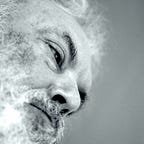Introduction to the Tao Teh Ching
by Hua-Ching Ni, published in ‘The Complete Works of Lao Tzu: Tao Teh Ching and Hua Hu Ching,’ Los Angeles: Seven Star Communications, 1995.
Lao Tzu’s Tao Teh Ching is one of the most cherished and frequently translated works in the world. Its pages contain the simple yet most profound truths of the universe. Among ancient and achieved people, Lao Tzu is considered the greatest teacher of all time and his given spiritual title is ‘Most Exalted One.’ He is regarded as a sage of highly revered energy, and legend states that he spent eighty-one years in his mother’s womb. In plain language, this means that it took many years for him to bear the fruit of wisdom.
As keeper of the ancient archives, Lao Tzu was well-versed in the wisdom and knowledge of China’s greatest sages before the time of the Yellow Emperor (2697 B.C.E.). His official position in the government was historiographer. In ancient culture, the historiographer was also in charge of observing celestial phenomena and consulting the I Ching for the imperial court. This custom continued throughout ancient times until the end of the Chou Dynasty.
As time passed, Lao Tzu became aware that a time of great confusion and spiritual disintegration was about to befall the empire. He decided to leave society and live a life in harmony with nature. Thus he rode westward on the back of a water buffalo. When he came to the Han Gu pass at the border of China, he was requested by the pass official to write down the essence of his wisdom. This classic has since been called the Tao Teh Ching.
Tao means the integral truth of the universe, Teh means the virtuous application of such high, subtle knowledge, and Ching means serious spiritual guidance.
Lao Tzu’s official duty as I Ching consultant for the state took him deeply into and beyond the I Ching. The I Ching was derived from simple ancient mathematics, but the ancients extended their minds beyond numbers. When the mind is fresh, it is easy to receive inspiration. The basic question is, why there are odd and even numbers? If you give up this basic structure of odd and even, no mathematics can possibly go further and no result can be inferred. By answering this simple question, you find the basic frame of yin and yang, the basic pattern of the intellectual mind.
Most people know some mathematics, but few ever question why there are odd and even numbers. The simple fact is similar to an apple falling from a tree, which kindled the discovery of Isaac Newton.
All cultural inspiration starts very simply, but after editing and reediting, the original simplicity is lost. It is the same once a great conception, philosophy or system of thought is turned into a religion, the original thought dies off. This is why I have such a deep appreciation for the Way: because its attitudes stay open to development, correction, improvement and refinement without insisting upon a final truth. The ultimate truth is beyond definition, although we all attempt to define it.
All religions harm the original spirit of life by condemning natural things as sex and eating as sins, never noticing they hold the power to continue human life. Rejecting something that is essential to life is human foolishness. This is why the sages said: ‘Let us just be quiet and let the world’s people fool around for another million years.’
The teachings of Lao Tzu are both rational and miraculous. They appear to be like a cup for clear, flavorless water, yet their subtle profundity is immeasurable. They are an expression of utmost simplicity and purest wisdom. They enable people at all levels of development to partake of this wisdom, just as pure water refreshes and supports all aspects of life. Many, however, are unable to accept this subtle power and mystical vision because these unadorned teachings do not arouse their imagination or stimulate their illusions. If these teachings did this, however, they would only be another impediment to true inner growth.
The truth is to keep moving. If you get stuck in one concept, the truth dies. This is why I call this teaching the Integral Truth.
